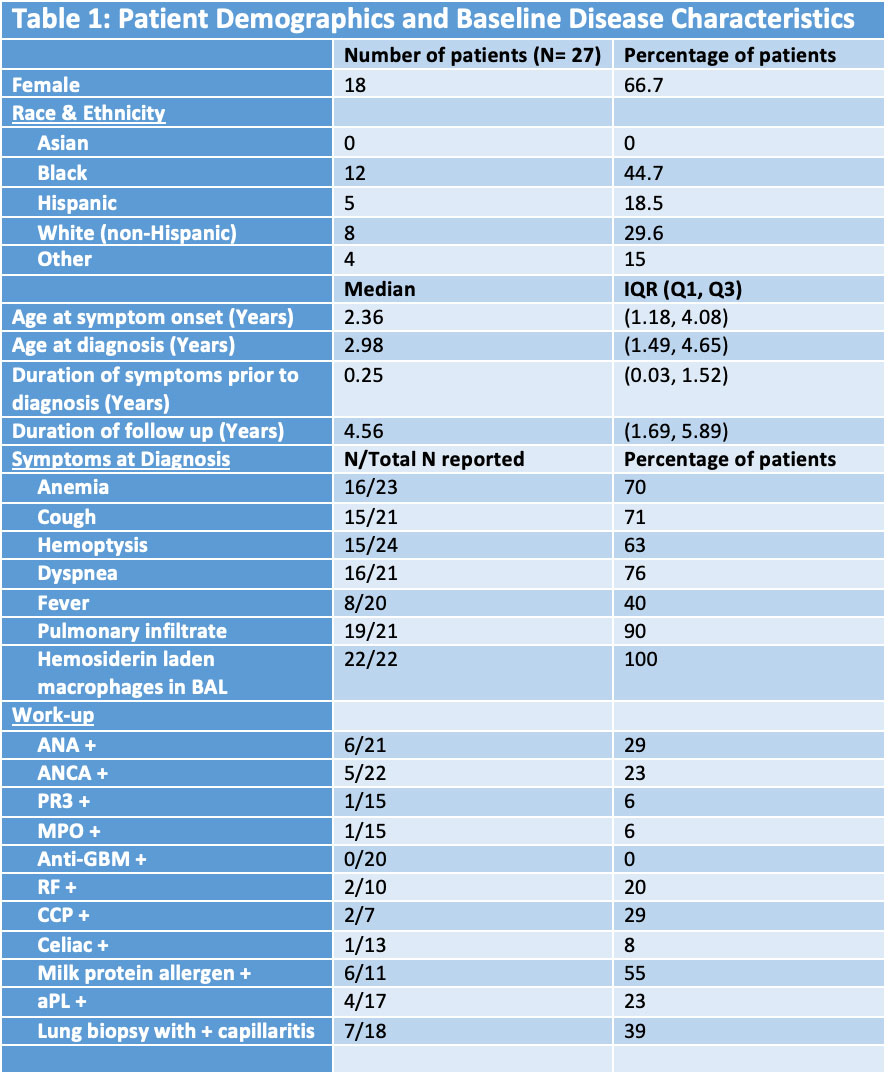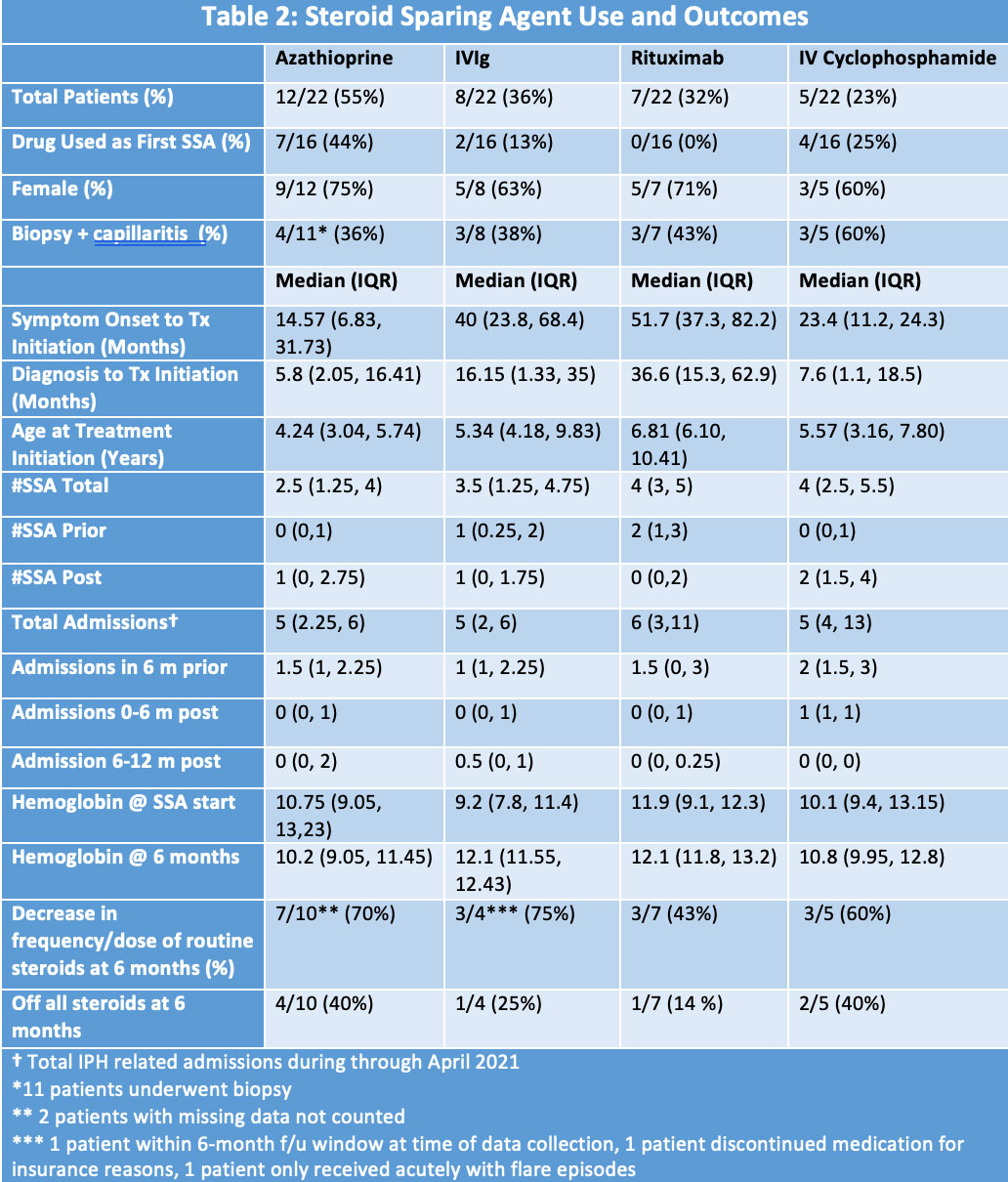Session Information
Session Type: Poster Session D
Session Time: 1:00PM-3:00PM
Background/Purpose: Idiopathic Pulmonary Hemosiderosis (IPH) is a rare, pediatric predominant condition causing episodic diffuse alveolar hemorrhage, which can be recurrent and life-threatening. Chronic steroid use has decreased overall mortality. Steroid sparing agents (SSA) are often used in recurrent disease in an attempt to limit corticosteroid (CS) toxicity. There are limited data describing therapeutic efficacy and steroid sparing nature of SSA.
Methods: Retrospective, cohort study was conducted at a tertiary-care children’s hospital. EHR was queried for IPH codes associated ICD 9/10 codes. Patients (age < 19) were included who had: symptom onset between 1/2012 and 4/2021; diagnosis of IPH by a physician; and either bronchoalveolar lavage (BAL) fluid with hemosiderin-laden macrophages and/or lung biopsy pathology consistent with alveolar hemorrhage without evidence of other disease. Patients were excluded for a known alternative cause for pulmonary hemorrhage or anticoagulation use at diagnosis. Data was collected on: CS dosing (IV & PO) at SSA initiation & 6 months (per drug); hospitalizations in prior 6 months & year following initiation; and hemoglobin level at SSA initiation & 6 months. Primary outcome was decrease in CS dose 6 months after SSA initiation defined as: decrease in weight adjusted, daily oral dose without increase in frequency of IV interval; spacing of IV interval without increase in daily oral dose: or decrease in both daily oral dose and frequency of IV dose. Descriptive analysis was performed.
Results: Among 156 patients identified by ICD 9/10 codes, 28 had confirmed IPH; one was excluded from analysis for history of lung transplant prior to study interval. Baseline data was collected on 27 patients; 22 patients had follow-up and outcome data. Median age of diagnosis was 2.98 years; 67% were female (18/27). History of prematurity was seen in 50% of patients (10/20) and Trisomy 21 in 2/27. Capillaritis was present in 39% of biopsies (Table 1). Most patients (16/22) received at least one SSA. The median number of SSA used was 1 (IQR 0.25, 3) but 2 (IQR 1, 3.75) in those who were treated with SSA. Ten drugs were used as systemic SSA (Figure 1). Azathioprine (12/16), IVIG (8/16), Rituximab (7/16), and Cyclophosphamide (5/16) were the most used SSA. Rituximab was never used as the first SSA. Overall reduction in steroid dose at 6 months following initiation of each agent is shown (Table 2).
Conclusion: There was a reduction in total CS dose and hospital admissions 6 months after SSA initiation for any SSA evaluated. This suggests steroid sparing agents are beneficial. The small cohort size makes comparisons among drugs difficult.
ICS- Inhaled corticosteroids; IFX- infliximab; MMF- mycophenolate mofetil; HCQ- hydroxychloroquine; MTX- methotrexate; IVIg – IV immunoglobulin, CYC ORAL – oral cyclophosphamide; CYC IV – IV cyclophosphamide; RTX- rituximab; AZA- azathioprine
To cite this abstract in AMA style:
Argraves M, Lerman M, Chase J, Goldfarb S. Pediatric Idiopathic Pulmonary Hemosiderosis – a Single-Center, Retrospective Study Comparing Use of Commonly Used Steroid-Sparing Agents [abstract]. Arthritis Rheumatol. 2022; 74 (suppl 9). https://acrabstracts.org/abstract/pediatric-idiopathic-pulmonary-hemosiderosis-a-single-center-retrospective-study-comparing-use-of-commonly-used-steroid-sparing-agents/. Accessed .« Back to ACR Convergence 2022
ACR Meeting Abstracts - https://acrabstracts.org/abstract/pediatric-idiopathic-pulmonary-hemosiderosis-a-single-center-retrospective-study-comparing-use-of-commonly-used-steroid-sparing-agents/



